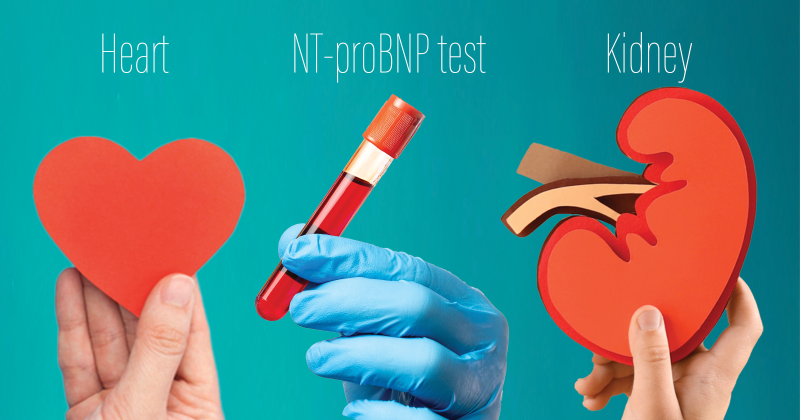
In a recent study involving 1,993 Chinese patients with type 2 diabetes (T2D) enrolled in the Hong Kong Diabetes Biobank, researchers from the Chinese University of Hong Kong (CUHK) demonstrated promising utility of N-terminal pro–B-type natriuretic peptide (NT-proBNP) as an independent prognostic biomarker for a variety of cardiorenal complications. Notably, use of NT-proBNP with established clinical risk factors improved prediction of cardiorenal complications over clinical risk factors alone. This article summarizes these findings and highlights the potential utility of NT-proBNP in clinical practice for identification of T2D patients at risk of cardiorenal complications who may benefit from early use of more intensive, organ-protective therapies.
NT-proBNP: Not just a heart failure biomarker
“NT-proBNP is an established biomarker for heart failure [HF] in individuals with or without diabetes. Emerging data suggest that it may also help stratify those at risk of cardiovascular disease [CVD] and renal dysfunction,” wrote the researchers. [Diabetologia 2024;doi:10.1007/s00125- 024-06299-x]
However, limited data are available on the use of NT-proBNP as a biomarker in Asian populations. Comprehensive evaluation of NT-proBNP’s utility for predicting cardiorenal complications in diabetes, compared with clinical risk factors, is also lacking. The CUHK researchers therefore evaluated clinical utility of NT-proBNP for prediction of cardiorenal complications and compared its performance with established clinical risk factors in a longitudinal cohort of Chinese patients with T2D enrolled in the Hong Kong Diabetes Biobank.
Hong Kong Diabetes Biobank study
Established in 2014 and coordinated by researchers from CUHK, the Hong Kong Diabetes Biobank is a multicentre prospective cohort that enrolls participants from 11 diabetes centres at major public hospitals across Hong Kong for biomarker discovery as well as validation and comparison of known biomarkers. [Diabetologia 2024;doi:10.1007/s00125- 024-06299-x]
Between 2014 and 2019, more than 20,000 patients with diabetes were enrolled in the biobank. Among them, 2,000 underwent baseline NT-proBNP measurement with an electrochemiluminescent immunoassay on a Roche Cobas analyzer. The current study included 1,993 patients with T2D (mean age, 61.1 years; male, 59.8 percent; mean duration of diabetes, 11.3 years) who had a baseline NT-proBNP measurement. They were followed up for a median of 5.1 years.
Using ≥125 pg/mL as cut-off, the researchers evaluated associations between elevated NT-proBNP levels and incident cardiorenal endpoints, including atrial fibrillation (AF), coronary heart disease (CHD), CVD, congestive HF (CHF), chronic kidney disease (CKD), kidney failure, ≥40 percent decrease in estimated glomerular filtration rate (eGFR), and a composite renal endpoint of onset of kidney failure or ≥40 percent decrease in eGFR, while adjusting for age, sex, and duration of diabetes. The independent effect of NT-proBNP levels was tested by further adjustment for baseline covariates, including smoking status, BMI, waist circumference, systolic and diastolic blood pressure, HbA1c, triglyceride, HDL- and LDL-cholesterol, albumin-to-creatinine ratio (ACR), eGFR, and use of medications. The prognostic and incremental predictive values of NT-proBNP for cardiorenal complications over the Joint Asia Diabetes Evaluation (JADE) risk equations for CHD, CHF and kidney failure, developed in a population of Chinese patients with T2D, were also evaluated.
NT-proBNP elevation common in T2D
Almost a quarter (24.7 percent) of study participants had elevated levels of NT-proBNP (≥125 pg/mL) at baseline. [Diabetologia 2024;doi:10.1007/s00125- 024-06299-x]
Patients with elevated NT-proBNP levels were older, more often male, had longer duration of diabetes, higher waist circumference (in female participants), higher waist-hip ratio, more adverse lipid profile, higher systolic blood pressure, higher urinary ACR, and lower eGFR compared with those with NT-proBNP <125 pg/mL. They were also more likely to be on lipid-lowering therapies, antihypertensives, oral glucose-lowering drugs or insulin. Cardiorenal complications were 2–4 times more prevalent at baseline among patients with vs without elevated NT-proBNP levels.
Elevated NT-proBNP associated with incident cardiorenal complications
Elevated NT-proBNP levels were found to be significantly associated with increased risks of incident cardiorenal complications. After adjustment for age at baseline, sex and duration of diabetes, NT-proBNP levels ≥125 pg/mL were associated with 2.51- to 5.99-fold higher risks of incident AF, CHD, CVD, CHF, CKD, ≥40 percent decrease in eGFR, kidney failure, and the composite renal endpoint during follow-up compared with NT-proBNP levels <125 pg/mL. (Table 1) [Diabetologia 2024;doi:10.1007/s00125- 024-06299-x]
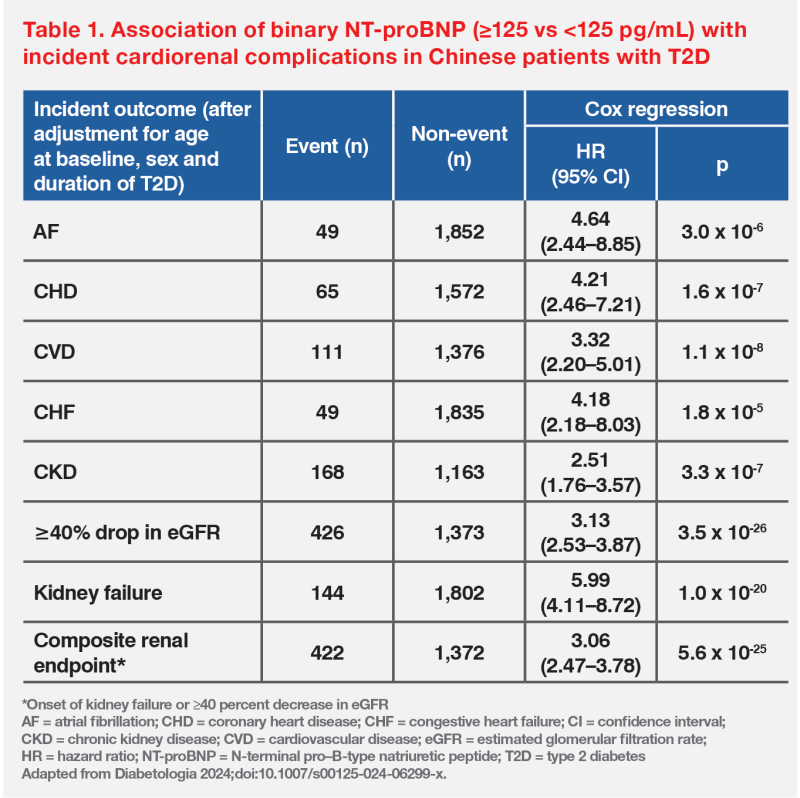
“All of these associations remained significant after further adjustments for baseline covariates,” the researchers noted.
Clinical utility of NT-proBNP as independent prognostic biomarker
“Elevated NT-proBNP was found to have good discriminative ability to identify those at risk of future [cardiorenal] endpoints,” the researchers reported. Concordance index (C index) ranged from 0.79 for CKD, and 0.80 for CVD and the composite renal endpoint, to 0.88 for AF and kidney failure, and 0.89 for CHF. (Figure) [Diabetologia 2024;doi:10.1007/ s00125-024-06299-x]
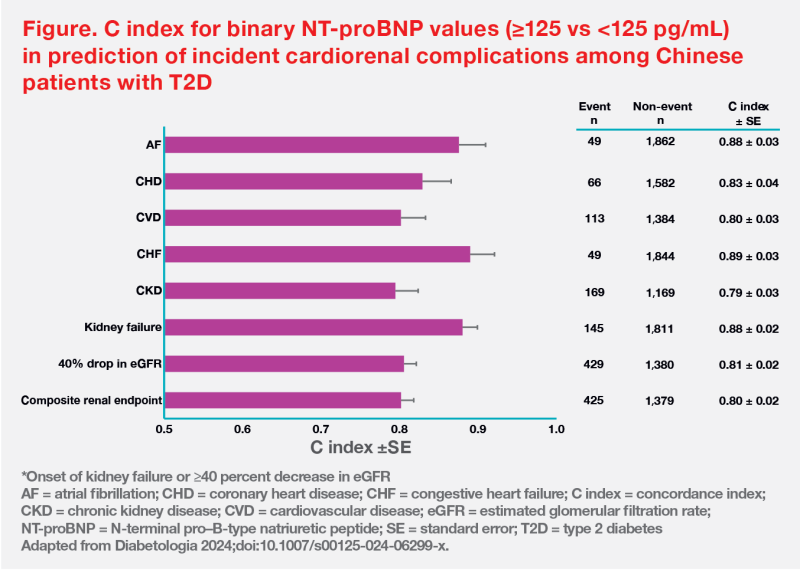
“Compared with established JADE risk equations for CHD, CHF and kidney failure, incorporating NT-proBNP enhanced prediction of each complication beyond that provided by clinical risk factors alone, with significant increases in C index,” the researchers pointed out. (Table 2)
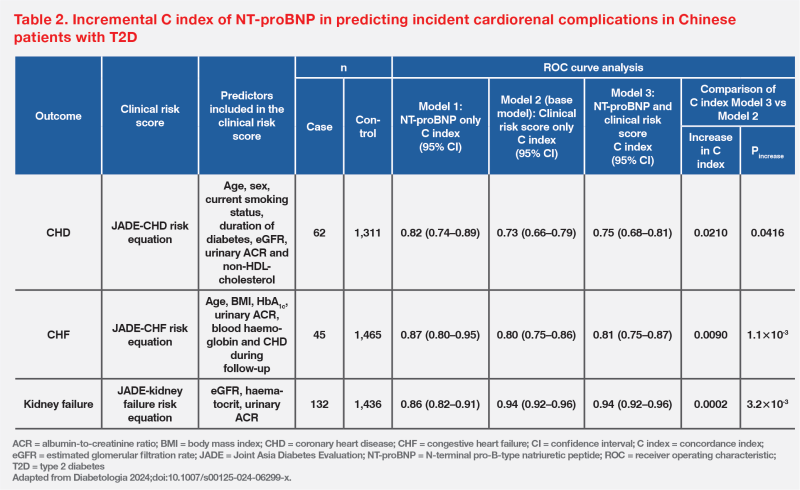
Analysis using net reclassification improvement (NRI) index similarly demonstrated significantly improved prediction of CHD, CHF and kidney failure with the addition of NT-proBNP to JADE risk equations. (Table 3)
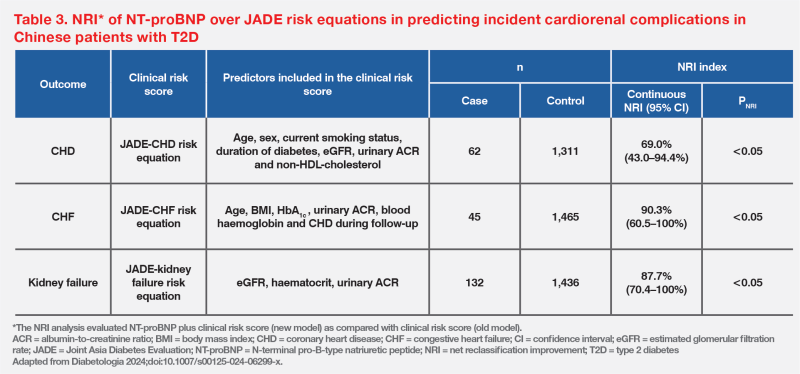
Strengths and limitations of the study
Strengths of the study included detailed documentation of clinical characteristics of the participants, prospective follow-up of multiple cardiorenal endpoints, high quality of biobank samples, as well as comparison of performance of NT-proBNP with JADE clinical risk equations for cardiorenal endpoints developed in comparable participant cohorts. [Diabetologia 2024;doi:10.1007/ s00125-024-06299-x]
A limitation of the study was the lack of adjustment for some classes of glucose-lowering medications, such as sodium-glucose cotransporter 2 inhibitors (SGLT2i) and dipeptidyl peptidase-4 inhibitors (DPP4i). “Although SGLT2i treatment was associated with lowering of NT-proBNP levels, they were only introduced in Hong Kong in 2014, and prescription of SGLT2i was restricted in public hospitals in 2014–2019. Thus, the number of individuals prescribed SGLT2i was limited,” the researchers explained. “In addition, previous studies suggested that DPP4i had no significant effect on NT-proBNP levels.”
Summary and impact on clinical practice
NT-proBNP is shown in the Hong Kong Diabetes Biobank study to be an independent predictor of cardiorenal complications in Chinese patients with T2D. Importantly, use of NT-proBNP with established JADE risk equations improved risk stratification of these patients compared with clinical risk factors alone.
“NT-proBNP may be a clinically useful biomarker for identifying T2D patients at risk of cardiorenal complications who could benefit from more intensive treatment, including prioritization of the use of organ-protective therapies,” the researchers suggested.